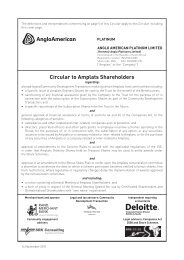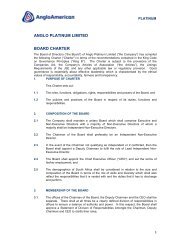Download PDF - Anglo American Platinum
Download PDF - Anglo American Platinum
Download PDF - Anglo American Platinum
You also want an ePaper? Increase the reach of your titles
YUMPU automatically turns print PDFs into web optimized ePapers that Google loves.
A.5.1Consideration of Alternatives andNegotiation for LandAvoid or Minimise ResettlementThe relocation of Ga Pila was motivated by incidences of fly rocklanding in the village from the operational Sandsloot pit, as well asthe need to extend the Mine’s life by creating additional space tostore waste rock (with the Ga Pila village presenting an ideal site).The fact that there was already an active pit and blasting activitiesonly 250 metres from inhabited settlements, would seem to indicatethat either the likelihood of potential resettlement was not identifiedat the time of mine design, or that alternative designs were nowconsidered and reflected further economic value in the open pit.The need for resettlement does not appear to have been identifiedas part of an early impact assessment for the Ga Pila site. Rather,the relocation was a reactive measure implemented by AP on thebasis of both safety concerns and requirements for storage of wasterock once mining was underway. An IFC aligned process wouldhave conducted an impact assessment up front and put measuresin place to mitigate impacts on affected communities prior to thecommencement of operations.Consultation on Land Rights, the EIA and other DecisionsAffecting the CommunityAP’s first point of contact in 1991 regarding the acquisition/lease ofVaalkop and Sandsloot farms, was the MTA, under the leadershipof Kgoshigadi Langa. Doing so was in keeping with acceptedtraditional authority protocols, whereby the Kgoshigadi and herCouncil are the highest authority and have the right to speak onbehalf of their communities. From this evidence it would seem thata negotiated approach to acquisition of land rights did take place, atleast in terms of accepted traditional authority protocol at the time.It is arguable that having agreement from the MTA, AP rightfullyinterpreted this to mean that the transaction was endorsed, or atleast not challenged, by the affected communities. A more criticalanalysis, however might argue that by negotiating with only thetraditional authorities and the Government, AP failed to recognisethe potential for this transaction to be disputed by communitymembers who had customary rights to the land as a communalresource even under the custodianship of the chief. Under the IFCstandards, this consultation with the Kgosigadi on land acquisition‘on behalf of the community’ raises questions about the inclusivity ofthe negotiated settlement, which ideally should have consulted withmembers of the community itself.mitigation findings of an EIA, but rather motivated by safety andother concerns around maintaining the viability of an alreadyoperational mine. These imperatives meant relocation had becomeinevitable, thereby giving the community no real choice in thematter. This means that, although community members wereincluded through an iterative process of consultation during latterphases of the resettlement process, AP did not achieve ‘Free PriorInformed Consultation’ on the critical decisions around the transferof the land and decision to relocate.Some accounts suggest that Ga Pila community members feltpowerless and not properly informed from the point of very firstcontact on the subject of the relocation. One could argue that thesecircumstances fostered mistrust between the community and APand, in many ways, set the tone for a reactive process right from thestart.A.5.2Inadequate Consultation andManagement of ExpectationsManaging ExpectationsA further critical weakness in the Ga Pila process was a continuedfailure to manage community expectations through theconsultation process. There is much evidence of AP attemptingto manage expectations but experiencing serious challenges.However, there are a number of issues around which information onexpected benefits was not clear enough, with AP failing to managethe associated risks and anticipate the full extent of communitydisappointment when they did not receive what they had hoped for.Community expectations must be understood in the contextof a newly democratic South Africa, however. Ga Pila was thefirst negotiated resettlement of its kind in the country. It quicklybecame a high politicised process where the stakes were high and,encouraged by regularly visiting politicians, community expectationsfor a bright future brought by the Mine were raised significantly. Thecommunity agreed as a collective to relocate partly because theyhoped for better lives. However, evidence during the review pointsto a lack of acceptance or understanding of information on certaincritical issues and poor communication of what the full impactsand implications of relocation would be. This was evident in theinadequate consultation relating to:• the audit and compensation, including on houses received;• inadequate house inspection process; and• expectations for employment.The study has shown, as previously discussed, that the actualdecision to relocate was similarly not based on consultation aroundvi


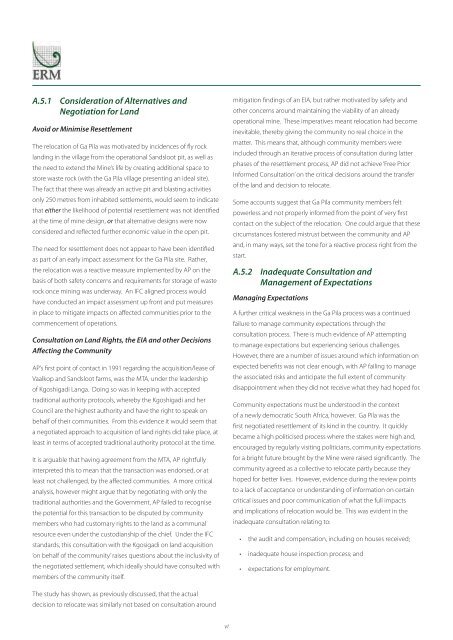
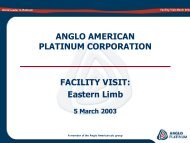

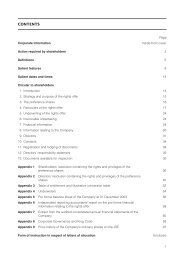

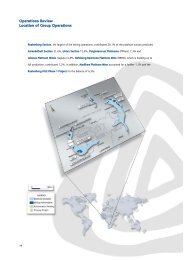



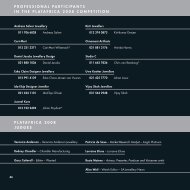
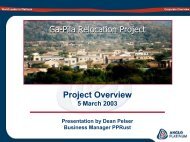

![[PDF] Mogalakwena Mine - Anglo Platinum](https://img.yumpu.com/43065142/1/184x260/pdf-mogalakwena-mine-anglo-platinum.jpg?quality=85)
